The Money Flow Index (MFI) is a momentum indicator in technical analysis that measures the inflows and outflows of money into a stock. MFI oscillates between 0 and 100 and is used to identify price reversals, market tops, and bottoms.
My testing shows that the Money Flow Index indicator is highly profitable. Over 26 years, it outperformed the S&P 500 stocks. Its total return was 1,690%, compared to a buy-and-hold strategy profit of 881%.
I tested the reliability of the Money Flow Index across the DJ30 and S&P 500, producing over 1,396 years of data. The Money Flow Index is a very profitable indicator. Learn how it works, how to trade it, and the optimal settings.
What is the Money Flow Index?
The Money Flow Index (MFI) is a technical analysis indicator that measures the flow of funds into and out of an asset over a given period. MFI is based on the relationship between the asset’s price movement and volume. The MFI scales between 0 and 100, with higher values signifying more buying pressure and lower values indicating more selling pressure.
The MFI is an oscillating indicator between 0 and 100; higher values indicate more buying pressure, while lower values indicate more selling pressure.
Money Flow Index is usually one of the first indicators beginner traders learn to use, but is it profitable?
Key Takeaways
- The Money Flow Index is an oscillating indicator fluctuating between 0 and 100.
- A Money Flow Index line below 20 is considered oversold and a potential buy signal.
- MFI above 80 is considered overbought and a potential sell signal.
- Based on our testing, the Money Flow Index can be highly profitable, with a 43% success rate.
- The Money Flow Index can be profitable with the optimal timeframe and settings.
If you’re looking for a reliable and accurate technical indicator to help you make sound stock market decisions, the Money Flow Index (MFI) could be the perfect solution. I time-tested this indicator, which has proven to provide traders with valuable buying and selling signals.
How does the Money Flow Index work?
The MFI measures the amount of money flowing into and out of an asset over time. It uses price and volume data to determine whether an asset is bought or sold in large quantities, allowing traders to speculate on possible market trends. Combining these two data points gives the MFI a more comprehensive picture of market sentiment than any single data point.
When interpreting the MFI, traders look for divergences between price and volume action that can signal an imminent trend reversal. For instance, if the price is increasing while the MFI is decreasing, it could indicate that buying pressure is waning and that a bearish trend may be on the horizon. Alternatively, if the price declines while the MFI increases, it could indicate that selling pressure is weakening and that a bullish trend may be imminent.
How to Trade Money Flow Index
When using the Money Flow Index, traders should look for buy signals when the indicator crosses up through 20 and sell signals when crossing down through 80. A common approach is to buy on an MFI reading below 20 and sell on an MFI reading above 80. This range of values has been empirically found to represent extreme market conditions where prices may be ready for a reversal.
Traders should also consider the divergence between price action and the MFI to anticipate potential reversals. For example, if prices are rising and the MFI is falling, it could indicate that a bearish trend may be on the horizon. Alternatively, if the price declines while the MFI increases, it could indicate that selling pressure is weakening and that a bullish trend may be imminent.
See the chart below for details on Money Flow Index buy and sell signals.
We independently research and recommend the best products. We also work with partners to negotiate discounts for you and may earn a small fee through our links.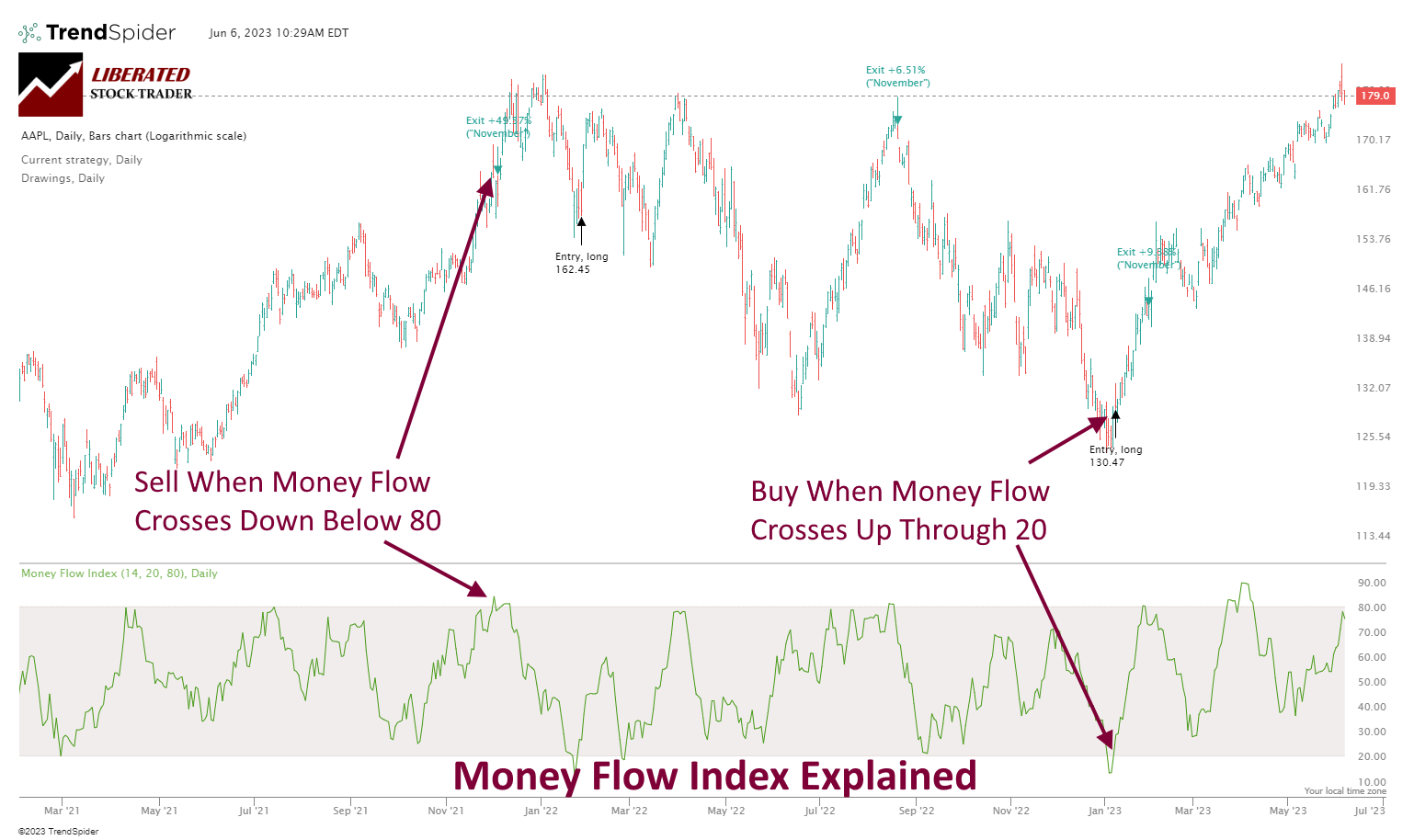
Chart Produced with TrendSpider
The big question is whether the Money Flow Index buy and sell signals are profitable, like the RSI indicator, or if the Money Flow Index is another chart indicator that does not work, such as moving averages.
How to Calculate the Money Flow Index
The Money Flow Index is automatically calculated and backtested using our recommended charting software, TrendSpider or Finviz. But if you want to calculate MFI yourself, read on.
The idea behind the MFI is that it takes the volume traded during each period and assigns it a positive or negative value, depending on whether the price went up or down. The indicator then accumulates this ‘money flow’ over a certain number of periods (the default period is 14) and presents it as an oscillator ranging from 0 to 100.
- Calculate the Money Flow Ratio by dividing the Positive Money Flow by the Negative Money Flow.
- Calculate the Positive Money Flow by multiplying the Typical Price by Volume for X Up Periods.
- Calculate the Negative Money Flow by multiplying the Typical Price by Volume for X Down Periods.
- Calculate the MFI using this formula: MFI = 100 – ((100)/(1 + Money Flow Ratio)).
Money Flow Index Formula
The Money Flow Index is calculated using the following formula:
Money Flow Index = 100 – ((100)/(1 + Money Flow Ratio))
Where:
- Money Flow Ratio = Positive Money Flow / Negative Money Flow
- Positive Money Flow = Typical Price * Volume for X Up Periods
- Negative Money Flow = Typical Price * Volume for X Down Periods
- Typical Price = (High + Low + Close)/3.0
Pros
The Money Flow Index is a versatile technical indicator that uses price and volume to measure buying and selling pressure. This makes it unique and an excellent indicator to combine with price indicators, like RSI or Rate of Change. MFI can identify potential buy and sell signals, giving traders an edge in their trading decisions. The MFI also helps traders anticipate trend reversals, allowing them to act quickly on market opportunities.
Cons
The main disadvantage of using the Money Flow Index is that, like all technical indicators, it does not always accurately predict price movements when used in isolation. When trading MFI, you can expect a 43% chance of beating a buy-and-hold strategy. Therefore, it is important to combine MFI with other technical indicators to increase the accuracy of your trading decisions. Additionally, the Money Flow Index does not consider factors such as news and company financial statements that can affect a stock’s price.
Finally, while the Money Flow Index can be used with all securities, its usefulness may be limited when trading stocks with low liquidity and volume. As the Money Flow Index relies on the volume of transactions to measure buying and selling pressure, it does not provide reliable results for low-volume stocks. Thus, traders should look to other technical indicators in such cases.
How I Set Up Money Flow Index Backtesting
To set up Money Flow Index backtesting in TrendSpider, follow these steps.
- Register for TrendSpider, select Strategy Tester > Entry Condition > Add Script > Add Parameter > Condition > Indicator > Money Flow Index (14) > Crossed Up Through Constant Level 20.
- For the Sell Criteria, select > Add Script > Add Parameter > Condition > Indicator > Money Flow Index (14) > Crossed Down Through Constant Level 80.
- Finally, click “RUN.”
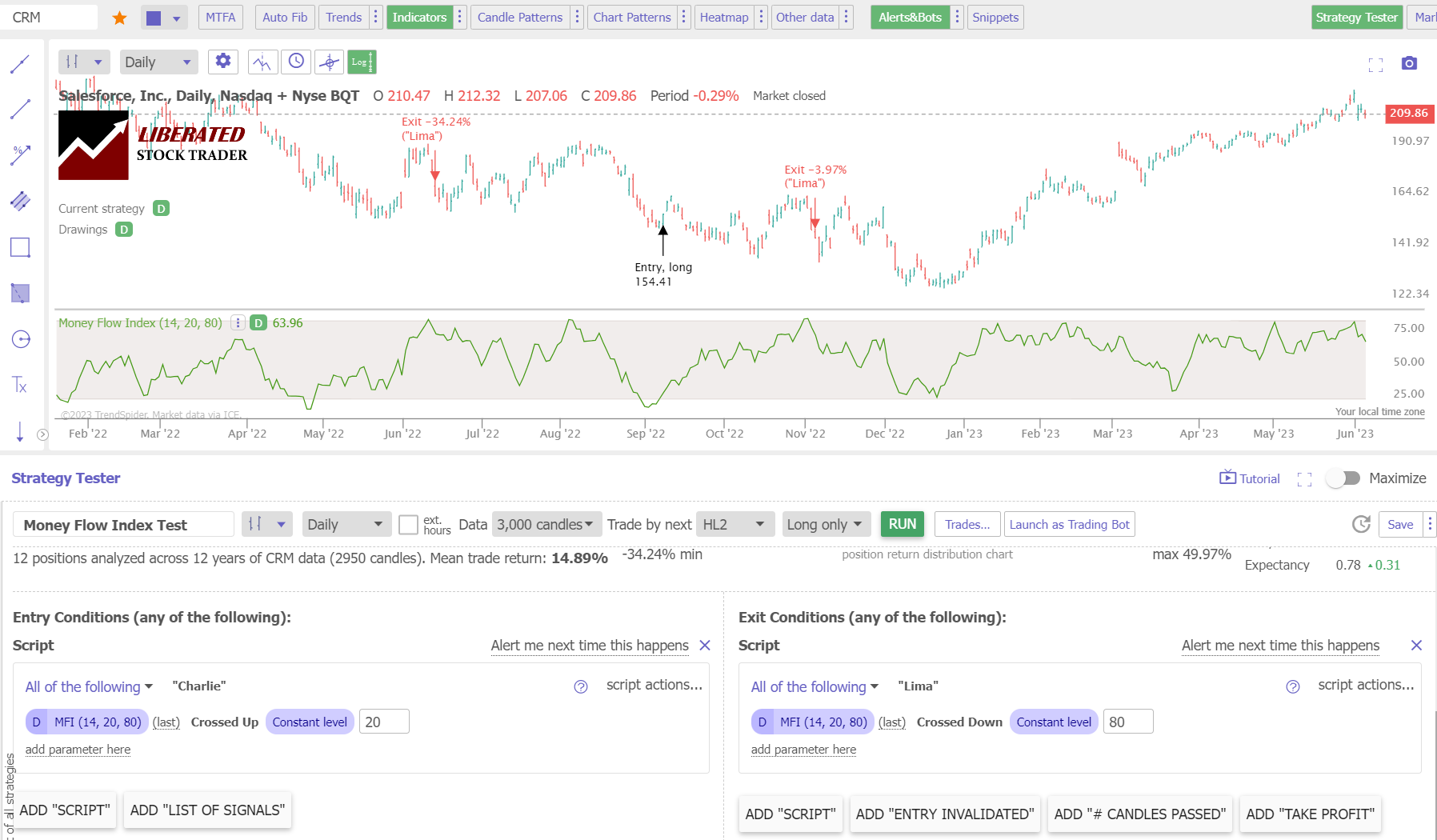
My thorough testing awarded TradingView a stellar 4.8 stars!
With powerful stock chart analysis, pattern recognition, screening, backtesting, and a 20+ million user community, it’s a game-changer for traders.

Whether you're trading in the US or internationally, TradingView is my top pick for its unmatched features and ease of use.
Explore TradingView – Your Gateway to Smarter Trading!
Want to test any indicator, chart pattern, or performance for any US stock? The award-winning TrendSpider software makes it easy! Our Trendspider review unveils insights into discovering the most powerful trading strategy development and testing service.
Backtesting Results
I tested the standard configuration of Money Flow Index 14 on the Dow Jones Industrial Average stocks on four timeframes: 1-minute, 5-minute, 1-hour, and daily charts, and the results were surprising. On a 1-minute chart, the Money Flow Index produced a 43% success rate, which is very high for a 60-second chart. MFI produced a 43% win rate on an hourly chart over two years versus a buy-and-hold strategy.
This means that 57% of stocks traded using this strategy did not beat a buy-and-hold strategy, but overall, combining all trades, this indicator produces outstanding results.
Interestingly, the standard setting of Money Flow Index 14 on a daily chart, widely recommended by supposed experts, produced an incredibly poor 10% win rate. However, in a later section, we will explore the daily RSI 14 trade on a much bigger sample size, the S&P 500.
| Money Flow Index Settings | OHLC Chart | Duration | % Winners | Avg # Trades |
| Setting 14 Best | 1-min | 20 Days | 43% | 30 |
| Setting 14 | 5-min | 3 Months | 23% | 26 |
| Setting 14 Best | 1-hour | 2 Years | 43% | 23 |
| Setting 14 | Daily | 12 Years | 10% | 16 |
| Average | 30% | 38 |
Best Money Flow Index Settings
Our 396 years of TrendSpider backtests revealed conclusively that the best setting for the Money Flow Index is using MFI-14 on a 1 or 60-minute chart. This produced a win rate of 43% versus a buy-and-hold strategy. That might not seem like more than a 50-50 chance of success, but the profitable stocks were incredibly successful, and overall, the strategy is successful.
Next, I will show a selection of those successful trades.
Money Flow Index Test: 60-minute chart
Our testing of American Express Company (Ticker: AXP) on a 1-hour chart over two years shows a Money Flow Index-14 strategy returning a profit of +60.7% versus the buy-and-hold return of +21%. There were 22 trades with an average win of 4.09% versus a loss of -3.84%. However, 77% of trades were winners.
It is rare to find an indicator that enables 77% of trades to be winners, which makes the MFI indicator profitable and very useful for traders.

Backtest Powerful Strategies on TrendSpider Now
A 4-Year Money Flow Index Test on a Daily Chart
Our testing of Dow Inc. (Ticker: DOW) over four years shows the Money Flow Index strategy returned a profit of +178% versus a buy-and-hold return of -2%. This is a vastly superior return, with 2 trades, and both were winners. The average trade return was 83.3%
This highlights the power of using tailored Money Flow Index strategies for long-term investments and short-term trades. Furthermore, this is just one example of the strategies available to traders with the right tools.
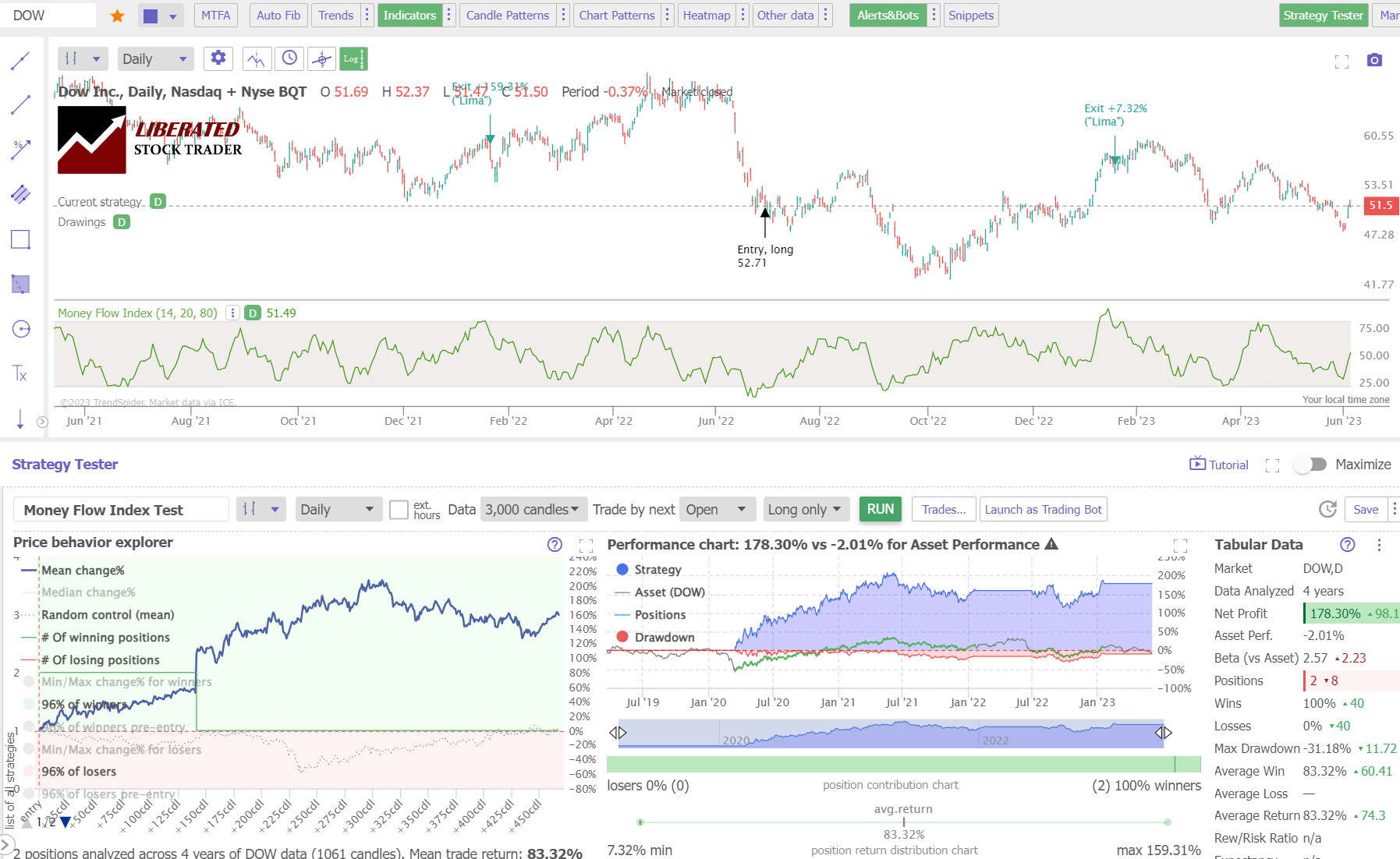
Get Point & Click Backtesting on TrendSpider
Testing Money Flow: S&P 500
To test the Money Flow Index on the 500 largest US stocks in the S&P 500, I used the excellent backtesting solution provided by FinViz Elite. Finviz’s point-and-click backtesting engine allowed me to test Money Flow Index-14 on a daily chart over the previous 26 years. Here are the results.
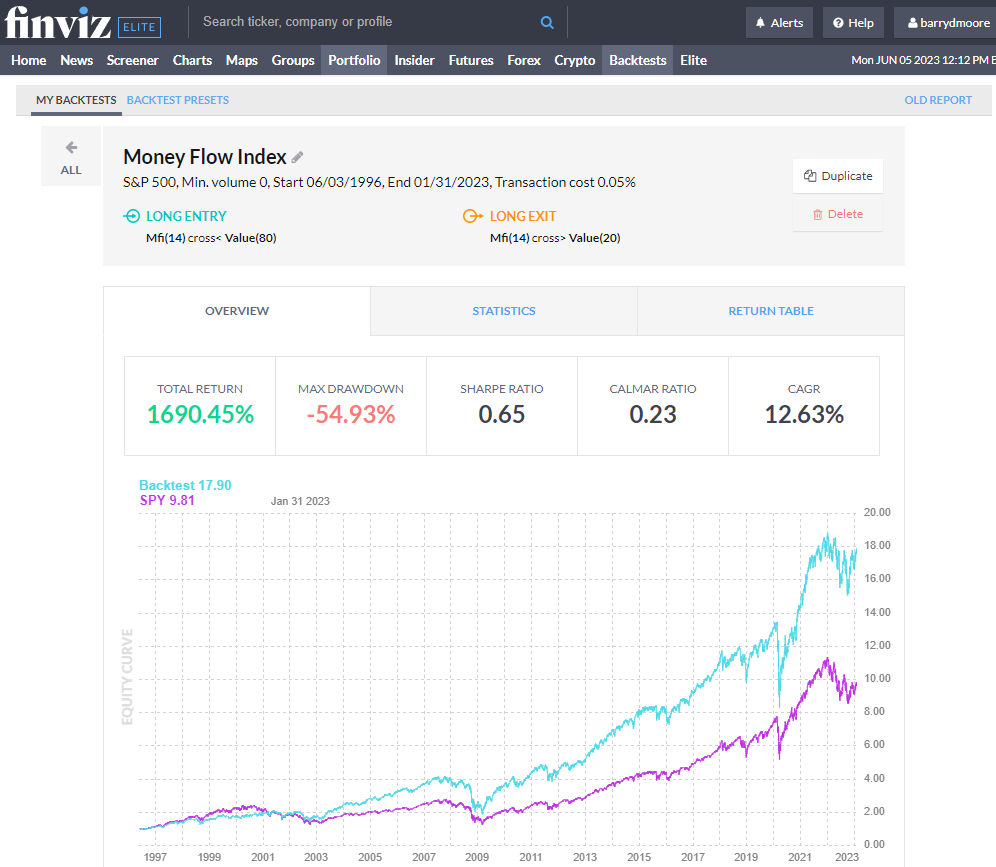
Get FinViz Elite Backtesting & Screening
26-Year Money Flow Index S&P 500 Results
With a 14 setting, the Money Flow Index outperformed the S&P 500 stocks over 26 years. It made a total return of 1,690% versus a buy-and-hold strategy profit of 881%. There were 23,524 trades, and 54% of trading days were winners.
Over 26 years, the Money Flow Index produced double the profits of a buy-and-hold strategy, making the MFI indicator one of the best I have tested.
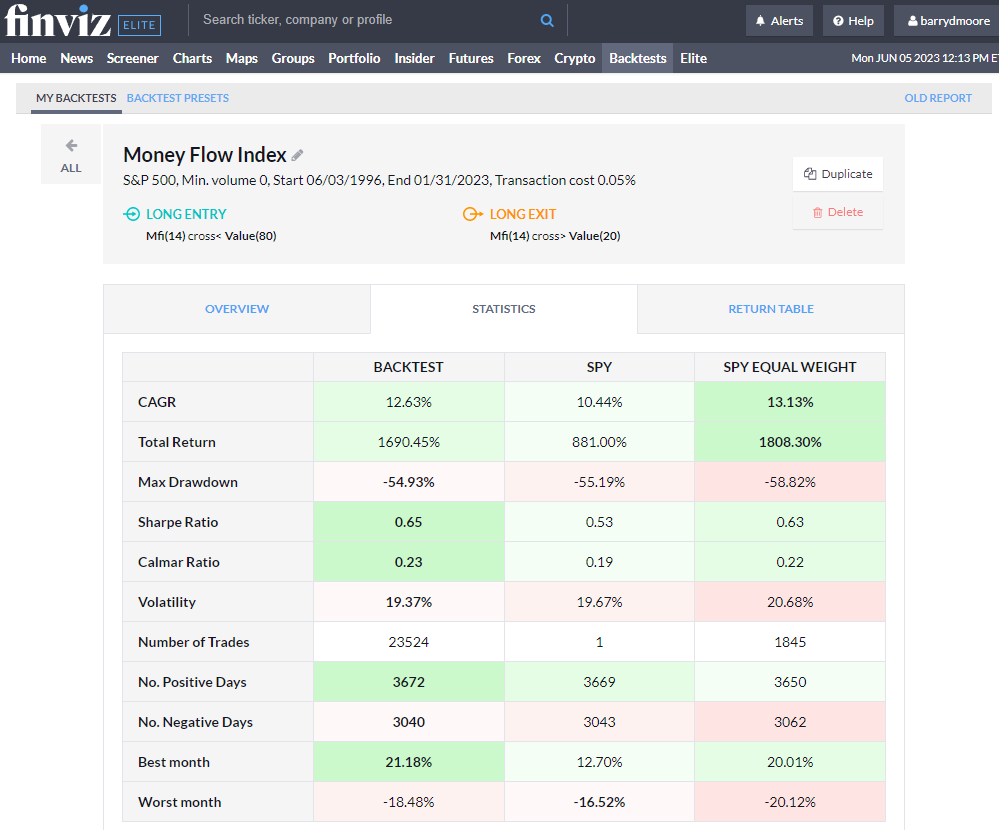
Backtest with FinViz Elite.
To set up Money Flow Index backtesting in FinViz, follow these steps:
- Register for FINVIZ Elite
- Select Backtests > Index=S&P500 > Entry When > Indicator > Money Flow Index Cross Less Than 80.
- For the Sell Criteria, select Entry When > Indicator > Money Flow Index 14 Cross More Than 20.
- Finally, click “Run Backtest.”
Combining Money Flow Index with Other Indicators
The Money Flow Index can be combined with other technical indicators to form a more profitable trading strategy. For example, using the MACD or Moving Average Convergence Divergence indicator, you can set up a strategy that buys when the Money Flow Index reaches positive values. At the same time, the MACD crosses above its signal line. Additionally, you can use the MACD’s Histogram to signal when a trade should be exited. Alternatively, combine the Money Flow Index with the Price Rate of Change, KST, or bullish chart patterns.
To test whether combining the Money Flow Index with other indicators is profitable, I suggest using TrendSpider, our recommended stock research, and AI-powered trading software.
Money Flow Buy and Sell Signals
Yes, the Money Flow Index is very good for buy and sell signals. Our 13,396 years of data across the DJIA and S&P500 suggests the standard Money Flow Index setting of 14 on a daily chart generates a market-beating 1,690% profit versus an index investing return of 881%.
Should You Use Money Flow?
Yes, our testing shows using the Money Flow Index is an incredibly reliable indicator, with excellent returns that outperformed the market during our 26-year testing period. MFI-14 outperformed the S&P 500 by 96%.
Is the Money Flow Accurate?
Yes, on 1-minute, hourly, and daily charts, the Money Flow Index is 43% accurate, producing many more profitable trades than other indicators. MFI should be the core indicator for your trading as it beats a buy-and-hold strategy. Over 26 years of testing, it produced a return of 1690% versus a buy-and-hold strategy profit of 881%.
Limitations
The Money Flow Index can be used successfully in isolation or further enhanced when combined with different chart patterns and indicators. This will help you avoid more false signals and larger losses.
Disclaimer: Trading involves a substantial risk of loss and is unsuitable for all investors. Past performance is not indicative of future results.
Is Money Flow Reliable?
Yes, the Money Flow Index is one of the most reliable and accurate technical analysis indicators. Based on our thorough backtesting of the S&P 500 stocks across 26 years, MFI outperformed the market by 96%.
Summary
After testing 13,396 years of data, we confirm that the Money Flow Index is a winning trading strategy. Use this indicator on daily and 1-minute charts, using the MFI-14 setting to improve your chances of trading profitability.
I have researched and tested many technical analysis indicators, and many indicators (like moving averages) underperform. However, the Money Flow Index has proven to be a winning strategy.
We have shown that the Money Flow Index is a proven tool for traders looking to enhance their trading strategies. Its accuracy and ability to produce strong signals can make it a valuable addition to any investor’s toolkit. However, traders should not rely solely on the Money Flow Index; instead, they should combine it with additional indicators and conduct their own testing.
FAQ
Is the Money Flow Index good for trading?
Yes, our research shows that Money Flow Index is a good indicator on 1-minute, 60-minute, and daily charts. MFI produced an excellent 43% average success rate versus a long-term buy-and-hold strategy. Our 26-year test of the S&P500 stocks proved MFI outperformed the market by 96%.
What is the best setting for Money Flow Index?
Our testing shows that the best setting for Money Flow Index is 14 on an OHLC/Candlestick 1-minute or daily chart; this configuration yielded a 43% win rate. Avoid MFI on a 5-minute chart, as this has only a 23% win rate.
What indicators are better than Money Flow Index?
There are very few technical analysis indicators better than the Money Flow Index. MFI is a very profitable indicator, but others are also reliable, such as Heikin Ashi charts, combined with the rate of change, RSI, and bullish chart patterns. Our testing has proven these indicators to be equally effective, work on many timeframes, and are successful in trading strategies.
Is the Money Flow Index the best indicator?
Yes, the Money Flow Index is one of the best indicators for trading. However, it can be improved in combination with other technical analysis indicators, such as Heikin Ashi, RSI, and bullish chart patterns like the Double Bottom, which can increase success rates up to 88 percent.
What is the best timeframe for Money Flow Index?
The best timeframe for Money Flow Index is a 14 setting on a daily chart, which produced a 96 percent gain over 26 years versus the S&P 500, according to TrendSpider. Using MFI on a 1-minute chart also produced a 43% success rate.
How reliable is Money Flow Index?
The Money Flow Index is a reliable indicator with high success rates. Our data proves the MFI outperformed the S&P500 over 26 years with a 1690% total return versus the SPY return of 881%.
What is the best software for trading and testing Money Flow Index?
Our in-depth Money Flow Index trading analysis relied on TrendSpider - the industry-leading trading tool for backtesting and strategy development. Its power and simplicity impressed me, making our research more efficient and successful.
Which is better, Money Flow Index or RSI?
Our 26 years of backtesting show that Money Flow Index is better than RSI, with an MFI return of 1690 percent, vs. RSI of 1282 percent. Both MFI and RSI are excellent indicators. I recommend testing them in tandem.
How to read the Money Flow Index chart?
To read the Money Flow Index, look for the line crossing down through the 80 line for a sell signal and crossing up through 20 for a buy signal. We tested this setting, and it works well.
What is the best software for Money Flow Index trading?
TrendSpider is by far the top software for trading and backtesting Money Flow Index; with point-and-click backtesting requiring no coding, it's a game-changer! TradingView is also good, offing pine code backtesting and global stock exchange, crypto, and forex coverage.
Is the Money Flow Index the same as a moving average?
No, the Money Flow Index is different from a moving average. There are four main moving averages; simple, exponential, weighted, and Hull. The Money Flow Index is an oscillating indicator with a different calculation and significantly better performance.
Does the Money Flow Index work?
Yes, the Money Flow Index works very well using standard setting 14 on daily charts, which is optimal. This setup is tested to have a 43% success rate on DJ30 stocks and a 96% outperformance on S&P 500 stocks.
How accurate is Money Flow Index?
The Money Flow Index is very accurate, especially with a standard OHLC or candlestick chart. Our research indicates that Money Flow Index has a 43 percent win rate, which is better than RSI, ROC, and Exponential Moving Averages.
How to make money trading the Money Flow Index?
Making money using the Money Flow Index is possible. The best way to succeed is by using an MFI-14 on a daily chart for higher reliability. Additionally, RSI-14 on a 1-minute chart works well.
Is the Money Flow Index effective for day trading?
Yes, the Money Flow Index is effective for day trading. Our test results on 1-minute and 60-minute charts show a success rate of 43 percent.
Try TradingView, Our Recommended Tool for International Traders
Global Community, Charts, Screening, Analysis & Broker Integration

Global Financial Analysis for Free on TradingView
